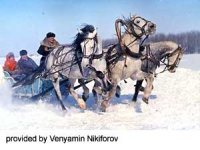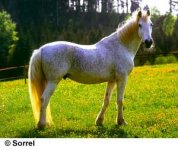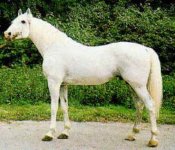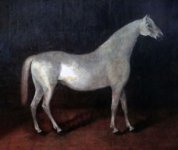♘امیرحسین♞
♘ مدیریت انجمن اسب ایران ♞
The Orlov Trotter was developed by A.G. Orlov at Khrenov stud beginning sometime between 1775 and 1784. The first date is that of the establishment of the Khrenov stud while the latter is that of the birth of Bars I, the progenitor of the modern pedigree Orlov. Arabian horses were crossed with the Dutch, Danish and Mecklenburg harness breeds. The Orlov evolved under the natural conditions of Voroezh region, characteristic of central Russia, and used natural pastures in the flood plain of the Bityug river. The combination of stable and pastures produced a breed with good action and adaptability to various management conditions. It thus became possible to spread the breed beyond the limits of Voronezh region to different climatic zones of the country, from Poltava to Perm regions, from Pskov to Kurgan regions and from Kirgizia to Altai territory. The Orlov is also taken to the mountain regions east of Lake Baikal as the principal improver of the native breeds.
The Orlov is widely used as a draught horse, as a utility horse for light and medium-heavy agricultural jobs, as a pleasure and competition horse and as the principal improver of small native horses throughout the former Soviet Union.
When the breed was being established and Bars I (a stallion of mixed Danish, Dutch and Arab origin) was in use at Khrenov stud, there were 77 mares of various origins there (10 Arabs, 2 Persians, 3 Caucasians, 1 Don, 32 English Thoroughbreds, 5 Mecklenburg and 1 Spanish). Bars' granddaughters, however played the decisive role in the establishment of the breed. The number of purebred Orlov Trotters changed depending on market conditions as well as social and economic factors. Significant damage to the breed was caused by uncontrolled crossing with the American Trotter during 1885-1913, as well as by the First World War and the Civil War, following which the breed had to be re-established. The first volume of the Orlov studbook in 1927 recorded 939 stallions and 1120 mares, while in 1954, Volume 8 listed 3228 purebred mares. Subsequently, however the number of horses in the breeding nucleus began to decline. Volumes 19 and 20 recorded 432 stallions and 652 mares in 1982.
The modern Orlov Trotter is distinctive in its type and conformation. Its head is well proportioned and clean cut, poll long and jaws broad, neck long and muscular and often high-set, withers medium in height and length, back long and flat and sometimes slightly dipped, loin of medium length and flat, croup straight and nicely rounded, chest wide, medium-deep, ribs well sprung, legs properly set and the joints well developed, often somewhat coarse. The forearm, cannon and metatarsus are medium in size, the pasterns often short and straight. The limbs are sometimes hairy. The colors are grey, bay, black and chestnut.
The measurements of stallions (in cm) are withers height 162, oblique body length 164, chest girth 187, and cannon bone girth 20.5; mares: 160, 164, 186 and 20.2, respectively.
The adaptability of the Orlov Trotter to either stable of pasture management has contributed to its spread to various parts of the country as well as to the development of specific lines. For instance, Dubrovski, Khrenov, Novotomnikov and Perm stud types have been formed, with distinctive exterior features. The Khrenov is the most popular standard type of the Orlov described in all textbooks and guides. The Dubrovski type is distinguished by smaller size, somewhat more primitive build, fleshiness and solid build. The Novotomnikov is characterized by its clean build, prominent "Arabian and swan-like" breed features and more rapid maturity. The Perm types is the most fleshy and large type with a somewhat coarse build characteristic of carriage horses.
The average speed of adult trotters is currently 2 min 20 sec for 1600 m; the record is 2 min 1 sec.
The Orlov is very fertile. At the studs there are 80-85 live births per 100 mares and the survival rate to one year of age is 78-83%. Its robust constitution and high adaptability result in a long life san. The outstanding stallion Kvadrat was used as a sire up to the age of 32, while the mare Gondola (b. 1933), having won the most prestigious prize at the Bars hippodrome, equivalent to the Derby, lived to the age of 27 years and produced 17 foals.
Pure breeding is the main method of producing the Orlov Trotter. No depression of the main economic characters occurs with up to 5% of inbreeding.
The reduction of the breeding nucleus at studs is mainly attributable to the breed's lower speed potential.
The breed consists of 12 sire lines and 16 mare families. The best studs are Khrenov, Novotomnikov, Perm and Altai.
The Orlov is widely used as a draught horse, as a utility horse for light and medium-heavy agricultural jobs, as a pleasure and competition horse and as the principal improver of small native horses throughout the former Soviet Union.
When the breed was being established and Bars I (a stallion of mixed Danish, Dutch and Arab origin) was in use at Khrenov stud, there were 77 mares of various origins there (10 Arabs, 2 Persians, 3 Caucasians, 1 Don, 32 English Thoroughbreds, 5 Mecklenburg and 1 Spanish). Bars' granddaughters, however played the decisive role in the establishment of the breed. The number of purebred Orlov Trotters changed depending on market conditions as well as social and economic factors. Significant damage to the breed was caused by uncontrolled crossing with the American Trotter during 1885-1913, as well as by the First World War and the Civil War, following which the breed had to be re-established. The first volume of the Orlov studbook in 1927 recorded 939 stallions and 1120 mares, while in 1954, Volume 8 listed 3228 purebred mares. Subsequently, however the number of horses in the breeding nucleus began to decline. Volumes 19 and 20 recorded 432 stallions and 652 mares in 1982.
The modern Orlov Trotter is distinctive in its type and conformation. Its head is well proportioned and clean cut, poll long and jaws broad, neck long and muscular and often high-set, withers medium in height and length, back long and flat and sometimes slightly dipped, loin of medium length and flat, croup straight and nicely rounded, chest wide, medium-deep, ribs well sprung, legs properly set and the joints well developed, often somewhat coarse. The forearm, cannon and metatarsus are medium in size, the pasterns often short and straight. The limbs are sometimes hairy. The colors are grey, bay, black and chestnut.
The measurements of stallions (in cm) are withers height 162, oblique body length 164, chest girth 187, and cannon bone girth 20.5; mares: 160, 164, 186 and 20.2, respectively.
The adaptability of the Orlov Trotter to either stable of pasture management has contributed to its spread to various parts of the country as well as to the development of specific lines. For instance, Dubrovski, Khrenov, Novotomnikov and Perm stud types have been formed, with distinctive exterior features. The Khrenov is the most popular standard type of the Orlov described in all textbooks and guides. The Dubrovski type is distinguished by smaller size, somewhat more primitive build, fleshiness and solid build. The Novotomnikov is characterized by its clean build, prominent "Arabian and swan-like" breed features and more rapid maturity. The Perm types is the most fleshy and large type with a somewhat coarse build characteristic of carriage horses.
The average speed of adult trotters is currently 2 min 20 sec for 1600 m; the record is 2 min 1 sec.
The Orlov is very fertile. At the studs there are 80-85 live births per 100 mares and the survival rate to one year of age is 78-83%. Its robust constitution and high adaptability result in a long life san. The outstanding stallion Kvadrat was used as a sire up to the age of 32, while the mare Gondola (b. 1933), having won the most prestigious prize at the Bars hippodrome, equivalent to the Derby, lived to the age of 27 years and produced 17 foals.
Pure breeding is the main method of producing the Orlov Trotter. No depression of the main economic characters occurs with up to 5% of inbreeding.
The reduction of the breeding nucleus at studs is mainly attributable to the breed's lower speed potential.
The breed consists of 12 sire lines and 16 mare families. The best studs are Khrenov, Novotomnikov, Perm and Altai.





